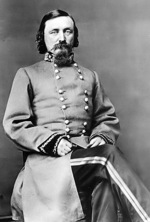The climax of the American Civil War Battle of Gettysburg that took place in July 1863 was a Confederate Army attack that has come to be well-known as 'Pickett's Charge', named after General George Pickett, General George Pickett one of the Confederate leaders on the field that day.
General George Pickett one of the Confederate leaders on the field that day.
Pickett's Charge was essentially a direct frontal assault by the Confederates, across an open field, uphill, against an entrenched Union Army enemy force that was supported by artillery on even higher ground.
Part of The Conference Board's Leadership Experience program at Gettysburg has the participants walk the same path across the field and up the hill that Pickett's (and many others) men traversed that day. The well-documented history of the battle tells us that the Confederates suffered horrific casualties, were unsuccessful in breaking the Union Army lines, and were forced to withdraw and retreat. Twenty-one months later the war ended, with the Union Army victorious.
As the leadership experience attendees traced the path of Pickett's Charge, it was seemingly obvious that attempting such an attack, covering almost a mile of open terrain, with the enemy dug in and holding the superior position, was absolute insanity. As we marched up the path towards the high ridge where the Union Army was aligned, one of the class questioned the 'march in a straight line in the open and approach the enemy' attack formation, that in 1863 was still the most common attacking tactic. This was troubling, since advances in technology and weaponry had improved the range, accuracy, and deadly force of the various artillery pieces, rifles, pistols, and ammunition.
The technology of war had dramatically improved to such an extent that it began to render the traditional tactics, if not essentially ineffective, certainly more costly in terms of casualties. And the crazy part is that one of the event facilitators indicated that the basic attack strategies continued all the way until World War I. But even then it required another technological breakthrough, (the tank), to significantly alter the accepted tactics.
I know the corporate world is not the same as the 'real' battlefield, and getting too comfortable with military metaphors risks oversimplification of what are usually complex issues. But in this case I think the comparison is appropriate.
New and better technologies are being created, improved, and being brought to bear with increasing frequency in a wide range of traditional human capital functions. Whether it is in recruiting, performance management, learning and development, or internal collaboration, the rate of advancement in capability and potential is accelerating.
But advances in technology, without an appropriate and complementary shift in the strategy and tactics to better leverage the new and more powerful technologies will only result in partial victory at best, and a significant loss at worst. Your competitors are likely to have the same access to these technologies as you go, simply 'owning' them will not be enough, being smarter and even bolder in their deployment will be the difference.
If you deploy fantastic new tools and technologies, but continue to execute in a 'march in a straight line across the field' manner, then history may be as unkind to you as it has been to General Pickett.
